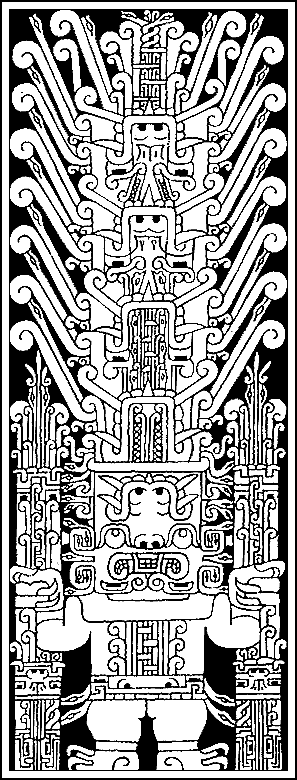Raimondi Stele facts for kids
The Raimondi Stele is a very important stone carving from the ancient Chavín culture. This culture lived in the central Andes mountains of what is now Peru. The Chavín people are named after their main site, Chavín de Huantar.
They lived there from about 1500 BCE to 300 BCE. This time is called the Early Horizon period. The Chavín were known for their unique art style. They often showed animals like big cats, snakes, and crocodiles. They also used a special "hanging pendant eye" design.
The stele (a tall stone slab) is seven feet high. It is made of shiny granite. It has a detailed carving of a main god, called the Staff God. This carving shows many of the Chavín art styles. The Raimondi Stele was not found in its original spot. Today, you can see it in the courtyard of the Museo Nacional de Arqueología Antropología e Historia del Perú in Lima.
Discovering the Raimondi Stele
The first modern person to write about the stele was José Toribio Polo in 1871. But he was more interested in another stone, the Lanzón, at the time.
Two years later, in 1873, Antonio Raimondi visited Chavín de Huantar. He was an Italian-Peruvian scientist. He described the site as a "fortress" and noticed the stele. The Raimondi Stele was not found in its original place. It was found in the home of a local farmer named Timoteo Espinoza.
People at that time often collected old objects. They would display them in their homes. This helped them connect with their history. It also helped protect these important items.
After the stele became known, Polo returned. He studied the stone in 1891 and 1892. Later, Julio C. Tello did more digging at the site. He found that other similar stones existed there. This led to more research into why these large stone carvings were made.
The Staff God and Chavín Beliefs
The main figure carved on the Raimondi Stele is the Staff God. This god is a mix of human and animal features. It has parts of humans, big cats, reptiles, and birds. These animals were very important in Andean cultures. They were powerful hunters living in the jungles near the mountains.
The strength of these animals showed the power of the Staff God. He was the most important god for the Chavín people. This carving showed his great power over everything.
The Raimondi Stele also shows a special kind of "duality." This means it has two meanings or images. The carving is perfectly symmetrical. This highlights the mirroring and double images. To see the other image, you would have to turn the whole stone upside down.
The Staff God was central to the Chavín worldview. The image was made hard to see on purpose. This helped separate those who truly understood from outsiders. To understand the stone, you had to interact with it. You might move your head, or even imagine flipping the stone. This active way of seeing helped people connect with the god.
The idea of transformation was important to the Chavín. The stone's ability to show two images reflected this. Duality was also a big part of their daily lives. They saw it in things like night and day, or life and death.
See also
 In Spanish: Estela de Raimondi para niños
In Spanish: Estela de Raimondi para niños



